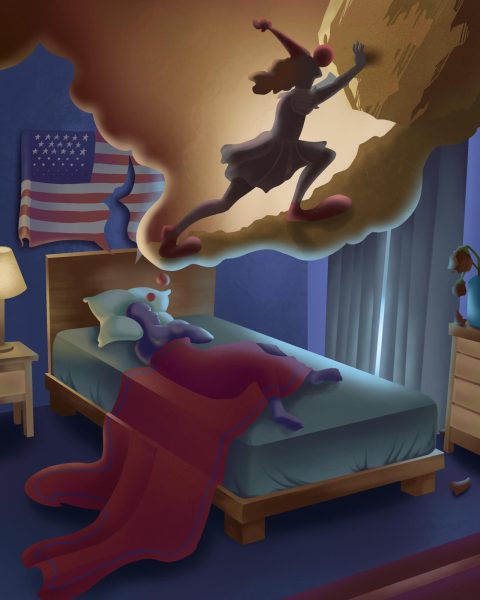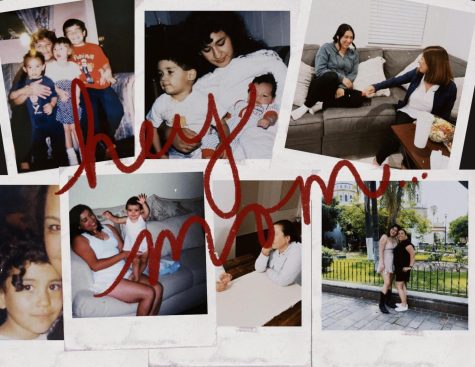Binging the Night Away
Television streaming services like Netflix and Hulu may be filling a void in your life that you don’t even realize you have.
You log onto your Netflix account (or your friend’s account that you’ve signed up on), and there it is. Your favorite series with “New Episodes” plastered across the logo. It’s like a gift from God. Better, even. You look at the clock. 11 p.m. You have to be up early for class in the morning. “Well,” you think, “One episode won’t hurt.” You click play, and the world around you disappears. You don’t even remember clicking the next button until the first rays of sunlight peek into your bedroom as you’re finishing the last episode of the season. Suddenly, your heart feels empty. Until the next night when you find a new series to watch and the oh-so-vicious binge watching cycle begins again.
Getting lost in a fantasy that lives only in your computer screen is now a reality. With so many television streaming services available at the touch of a button such as Hulu, Video On Demand, and Netflix, it is possible for someone to spend days watching episode after episode of their favorite series. For many, sitting alone in front of their laptop viewing an endless parade of programming has become an escape unlike any they’ve ever experienced.
This trend, commonly known as “binge watching,” has revolutionized the way young people watch TV. In fact, for the first time since its invention, millennials are no longer subscribing to cable television services, instead opting to subscribe to streaming services — a cheaper, more tech savvy option. This switch has provided the ability to watch an entire season (or multiple seasons) of a show in one sitting; an opportunity many choose to indulge in on a regular basis.
Binge watching has recently been linked to depression, according to a study conducted by the University of Texas at Austin. The study cites some millennials as lacking self regulatory skills. In other words, it was physically impossible for them to stop clicking the “next” button, despite the fact that they had other things to do, and the longer they watched the worse they supposedly felt. This behavior is seemingly consistent with addiction, which poses a new question: is it possible to become addicted to Netflix?
According to Kristen Campbell, 23, who recently graduated from Loma Linda University with her master’s degree in marital and family therapy, although an addiction to Netflix specifically isn’t clinically recognized, the act of consistently binge watching can be.
“Binge eating, drinking, or watching would fall more likely between categories [of addiction], or under abuse. Both require recurrent use resulting in the failure to fulfill major role obligations at work, school or home,” Campbell said.
However, if these are the qualifications of addiction, most people who binge watch would not qualify as addicted and participate in binge watching because it makes them feel good and offers a temporary respite from their fast paced lives, contrary to what the study at the University of Texas at Austin found. A 2013 survey conducted by Harris Interactive found that 61 percent of the adults they surveyed binge watch regularly, and 73 percent of that portion feel good about it.
Katia G Tyra, a 21-year-old retail worker at GameStop, said that she binge watches about once a month, for one to two hours at a time.
“The average is maybe one to two hours, sometimes three. The longest was probably five or six hours during winter break,” Tyra said.
Tyra, who loves binge watching everything from That ‘70s Show to House of Cards, said that she does not consider herself addicted to streaming television, and it is more of a relaxation technique than anything else.
“I can go without it,” Tyra said. “It doesn’t interfere with my daily practices or routine. It’s more of a way to relax or something to do in my free time.”
Sarah Alumbaugh, a 23-year-old public relations intern, echoed her sentiments. Alumbaugh said she binge watches for about 2 hours at a time a few times a week, and that it does not keep her from fulfilling her daily activities and obligations.
“If I’m working on something, I’ll usually have Netflix on in the background,” Alumbaugh said.
Mark Alcon, a 24-year-old professional chef at Disneyland Resort, who binge watches for four to five hours three to four times a month, also said his binge watching habits do not interfere with his daily life.
“It has never impacted my work or social life or kept me from anything,” Alcon said.
Cultural anthropologist Grant McCracken, who recently worked with Netflix to study the binge watching phenomenon, said that our fast paced, digital lifestyle leaves us craving long-form storytelling.
“TV viewers are no longer zoning out as a way to forget about their day,” McCracken said. “They are tuning in, on their own schedule, to a different world. Getting immersed in multiple episodes, or even multiple seasons, of a show over a few weeks is a new kind of escapism that is especially welcome today.”
Escapism is certainly what it seems to be about for many who participate in binge watching. The opportunity to become invested in a fictional character or characters life can leave viewers emotionally invested in a show, thus ensuring that they will keep watching.
Orange is the New Black, an immensely popular Netflix series starring Taylor Schilling, is arguably a fan favorite of binge watchers. This series, which follows the story of Piper Chapman as she is imprisoned at the fictional Litchfield Penitentiary, based on the true life tale of Piper Kerman, has captured viewers attention in a way that no series ever has before.
Elizabeth Dalton, a 22-year-old agriculture major at Cal Poly Pomona, said that Orange is the New Black is the only series she can watch for hours on end.
“I don’t know what it is about that show,” Dalton said. “I find myself watching these characters and really caring about what happens to them. Like when Piper fired Flaca in this last season. I found myself so angry it was almost funny.”
In her book Why Do We Care So Much About Literary Characters? Blakey Vermeule theorizes that when reading or watching a fictional story, we see and hear almost everything. We get to know the characters better than we know the people around us. Actors are most often very adept at letting the viewer know just how their character is feeling through facial expressions and body language queues. Instead of only being able to imagine what the character looks like, as with novels, we are able to see and hear this character. We form connections with these characters that, according to Vermeule, we may be lacking in our everyday lives.
With our fast paced lives that tend to limit face-to-face interactions, it is understandable that we may binge watch on a conscious level to relax or battle boredom, and also to fill a void subconsciously.
Dalton, who binges three to four times a month for two to three hours on average, said that she thinks it’s a reasonable explanation for why many people her age participate in binge watching.
“I’ve never really thought about like that before,” Dalton said. “But it kind of makes sense. I mean, a lot of our social interaction takes place on our phones, and it’s not even through phone calls anymore. It’s through text and Facebook. Not only can you not see the person you’re talking to, you can’t hear them either. You can’t hear the inflection in their voices or read their facial expressions and I think that’s an important part of social interaction. So, it’s entirely possible that we’re all doing it to get something that we’re not getting in our everyday interactions anymore.”
Derrick Johnson, 24, who received his bachelor’s degree in communications from the University of Riverside in June, said, “It’s weird, because it’s something we’re only seeing with our generation because we’re the first generation to grow up with such a significant surge in technology.”
Johnson explained that things one or two generations ago were much simpler, and there isn’t a previous generation that’s had as big of a technology surge in their childhoods as Millennials have had.
We’re also the last generation that will remember what it was like to play outside until the streetlights came on. Our parents and our grandparents generations, when you wanted to see someone you went to their house and hung out with them. You wanted to speak with someone far away, you wrote them a letter or talked on the phone. Now we text, we Facebook, we Facetime. So there’s nothing, no data to compare it to, just us.”
Johnson said he uses social media and texting as a way to keep up with friends from high school, and friends he hasn’t had time to see since starting his first post-college job. Johnson also said he tends to binge on the weekends during the day, for three or four hours at a time, two to three times a month.
Our generation, the colloquial Millennial generation, has seen a surge in technology during our childhoods that no other generation before us has ever seen. When I was 5, 18 long years ago,I had a walk-man that I would listen to Mariah Carey cassette tapes on. The average cassette tape held 23 minutes on each side, which is about 11 to 12 songs per tape. Now, I have a 16 gigabyte iPhone with 500 songs and room for lots more literally at my fingertips. When I was a kid, if you wanted to watch something on TV and you couldn’t view it live you either taped it on your VCR or you missed out. There was no TiVo, Netflix or Hulu. So, do we binge watch because all of this technology has taken over our lives, made them too easy, and left us hungry for real, human relationships and emotions? Or is it just because it’s something relaxing to do during your free time? Only time will tell.
Photo illustration by Albert Serna Jr
Substance is a publication of the Mt. San Antonio College Journalism Program. The program recently moved its newsroom over to Medium as part of a one-year experiment. Read about it here.











